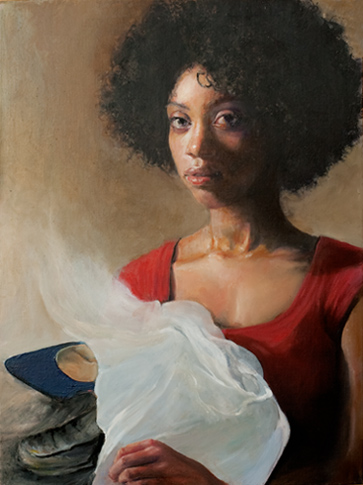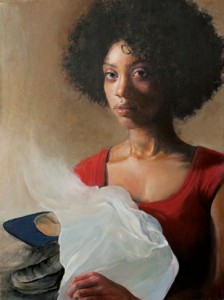
Last year, based on past work and exhibitions, I was juried into the Hillyer Art Space 2010 season to have a solo show. I had just about finished painting my last series (which was on the effects of global issues on the individual), and was ready to begin something new. I started three paintings, one after another, each on subjects that just didn’t feel right in a way that would sustain a whole series. Then I came across a thought experiment by the political theorist John Rawls.
Rawls’ “veil of ignorance” suggests that we hide from ourselves our personal social status, ability, and income, when we make decisions about systems of justice. He suggests that a “veil of ignorance” helps us consider the interests of the least advantaged members of society, and make the best choices for everyone. Inspired by this hypothetical system inspiring social justice, I found that I could not stop painting. The paintings poured out of me.
 For more than thirty years my work has centered on social justice issues seen throughout history. I’ve painted on such themes as the steps taken by the Truth and Reconciliation Commission in South Africa, the victims of suicide bombings, and the uncertainty of bringing a child into this world. The most intriguing part of the veil is that Rawls used such a strongly visual image to explain his concept. I thought that if I could capture that wonderful idea, I would have something special. In the past, a symbol often stood alongside the model to convey a sense of time and place. However, the veil enabled a cohesive, natural, woven image. The veil might be light and airy and dissolve into the atmosphere, or it can be a thick shroud that hides part of you. For example, in my painting titled “Veiled Judgment” (seen on this page) the veil almost floats before the woman in the painting, largely obscuring two strikingly different symbols of social status: a worn worker’s shoe and a stylish high-heeled one, and thus leaves the woman’s station in society in doubt. It became clear to me that if a veil were set in between the subject of the painting and the viewer, either one could be considered “behind” the veil depending on one’s point of view, as is the case in “Veiled Identity.” In this way, I hope the veil engages the viewer, strengthening your interaction with the painting.
For more than thirty years my work has centered on social justice issues seen throughout history. I’ve painted on such themes as the steps taken by the Truth and Reconciliation Commission in South Africa, the victims of suicide bombings, and the uncertainty of bringing a child into this world. The most intriguing part of the veil is that Rawls used such a strongly visual image to explain his concept. I thought that if I could capture that wonderful idea, I would have something special. In the past, a symbol often stood alongside the model to convey a sense of time and place. However, the veil enabled a cohesive, natural, woven image. The veil might be light and airy and dissolve into the atmosphere, or it can be a thick shroud that hides part of you. For example, in my painting titled “Veiled Judgment” (seen on this page) the veil almost floats before the woman in the painting, largely obscuring two strikingly different symbols of social status: a worn worker’s shoe and a stylish high-heeled one, and thus leaves the woman’s station in society in doubt. It became clear to me that if a veil were set in between the subject of the painting and the viewer, either one could be considered “behind” the veil depending on one’s point of view, as is the case in “Veiled Identity.” In this way, I hope the veil engages the viewer, strengthening your interaction with the painting.
Now a week away from the June 4th opening, I am obsessing about finishing up, reworking paintings that have already been photographed, and even inviting models over with new paintings in mind. I guess I like to work under pressure. Please comment here if you have any questions or thoughts, and I hope you’ll come by the opening and let me know what you think.
Judith Peck has made it her life’s work to paint about the history and healing of social injustice. A graduate of the George Washington University with a degree in fine arts, she has exhibited her work in venues nationwide, including the Center for Civil and Human Rights in Atlanta, GA, and the Rhonda Schaller Studio in Chelsea, NY, as well as in such print media as Ori Soltes’ book The Ashen Rainbow and the San Francisco City Concert Opera Orchestra’s announcement for “Die Weisse Rose.” Peck’s latest series “Original Position” will be showing at the International Arts & Artists’ Hillyer Art Space from June 4th to June 26th with an Artist / Curator Talk to be held Saturday June 5th from 5 to 7 pm. You can visit the artists website at www.judithpeck.net.
For a look at more paintings in the exhibition, go to http://inkandescentpr.com/article/?c=judith-peck. I find this concept of the veil of ignorance quite fascinating. Imagine what the world would be like if there were no social status, if everyone truly treated others in the way that THEY would like to be treated. If we were unaware of our “place” in society, it would be in our best interest to treat others equally.
For more information on this fascinating exhibition, go to:
http://inkandescentpr.com/article/?c=judith-peck
How refreshing, this depth of thought and depth of research combined. Individual and collective issues presented in a complex, intuitive mannner that has me revisiting each work over and over. Has propelled me to discover Rawls’ work as well. Good luck with show! Can’t wait to see the “new” stuff.
Judith Peck’s work has a nervous energy that is reminiscent of a volatile potion in a renaissance alchemist workshop. The culture and nature of her work represents a veiled message more so than any symbolic veils included in their composition. I am really excited about Peck’s work because it continues to evolve and rarify communicating a message that I believe even she is still not very aware of it. These are good works that go beyond her reasoning mind. These are unreasonable works. It seems she cannot manage this higher reason, this newness which continues to be beautifully informed by her love of the renaissance masters and at the same time contains its own graceful message. The contrast between the way her subjects stare at us and the story she makes them tell create a counterpoint that invites our curiosity to keep on looking at her work. It all seems uneasy, uncomfortable, but not exactly disturbing. She makes us curious. And looking at how her work evolves I cannot help but notice this curiosity is genuinely her own coming through. It seems these are records of her experimentation and discoveries that even she does not understand yet. It must be her desire to uncover her own reality, hidden in the expression of her portrait subjects, which propels her to keep exploring this strange world portrait after portrait. I am excited to see these and I am curious about what she will reveal in her subsequent work. I believe she is a new day alchemist delving into unknown possibilities of grace and growth.
I am looking forward to seeing Judith’s newest series at Hillyer. As a fellow painter, I read this article with great interest and curiosity as to how her topic of choice — social justice — will be depicted. The painting “Veiled Judgment” surpases my expectation and can’t wait to see the rest of the series.
Your work is very powerful!!! Wish I could come to the Fridge Show but am in West Virginia now.
Judith Peck’s paintings are among the most compelling I’ve ever seen, her portraits both astonishing and riveting. Historical injustice and issues confront us, not as large scale abstractions but as intimate personal encounters, as we find ourselves suddenly face to face with a person we would never have expected to encounter standing directly before us, a person whose eyes look directly at us and perhaps into us, taking the measure of our reaction to the violence, the coercion, the humiliation and where it is we stand, and have stood, in relation to it all. In these faces, in these eyes, we do not see defeat; Judith presents us with the spirit, the dignity, the integrity that could not be destroyed even if bodies were killed. Millions who were silenced and disappeared have not been totally erased after all, Judith Peck has seen to that. Their presence is felt here, in an encounter of painting and viewer the like of which I have never experienced before. These portraits are so intensely alive that it becomes a question of who is taking the measure of whom: the viewer of the portrait, or the portrait sizing up the viewer. The silencing of the past continues, as the painted figures cannot speak, but the words — the statements, the questions, the challenge — are present in eyes that speak volumes. Judith Peck is a master of the silent dialogue. I recall at this moment her painting of the question for women as to whether they their full, sensual presence must be silenced to keep others comfortable, the painting that reflects our holding of the Earth and its future — and our own, her painting of the grandmother that knows she survived the holocaust and has triumphed because she has lived to see a granddaughter come into adulthood, and now this painting in which we see our own ambivalent wish to know and to not know our place in the world, and the place of others. The veil of ignorance allows us the blurring of fantasy and reality, what we wish to be and what we are so far fated to have been, life in the real world and the life we should be living were our dreams to be true. Who are we to ourselves, and to each other? This veil of not quite knowing: how does it help us in this life, and what does it take from us? What does it mean to this woman, and what does she ask us about ourselves in relation to her as she reveals this most intimate blurring that is part of her life? Judith Peck loves talking with others about the issues in her work. She is a master of words as well as of the brush. To hear her speak about this painting — and others — in person will be a treat not to be missed.
Wonderful presentation of individual and collective consciousness. All is as one. Intimate expression of dutiful research, heartfelt contemplation and soulful execution. Can’t wait to see the new stuff!